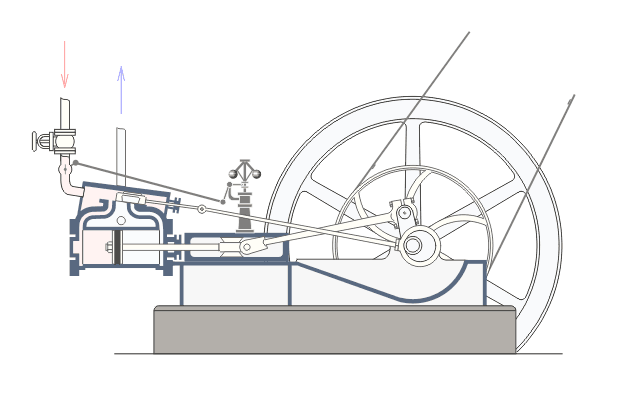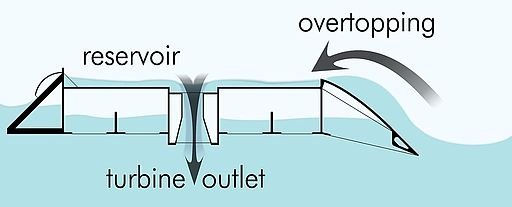Ocean Energy: Enegy from Ocean Waves - Part 3.
In the last post, we discussed how to collect energy from the ocean waves using a bidirectional wind turbine. In this post we shall discuss two much easier means that serve the same purpose. May be I should have started with the easier ones...lol.
Oscillating body systems (OB systems):
Well, you know oscillations, right? And you know body, and you know systems, lets end this topic here... just kidding.
For Oscillating Body (OB) systems, first we need two bodies, any suitable shape and size will do. These bodies should be able to move with respect to each other, in an oscillating fashion. You know to and fro like a swing, or up and down like a piston attached to a vertical spring. Or like the Pelamis wave energy converters – in their case, joints move up and down while the cylindrical body tilts with the wave. The Pelamis are out of business now, but they were real famous for a really long time.
Let's begin...
- It uses the waves to oscillate. Waves themselves have the oscillatory motion, we just need to bring something that can float in contact with them, and that object will oscillate with the waves too.
- This system of oscillating body and a piston drive a turbine rotor, it's that simple. We just use pistons to get this done, sometimes there are other mechanisms, but the end result has to be the same... rotation of the damn turbine. The longer and faster it rotates the better.
We started with saying we need two bodies, right? But if both bodies move up and down with the wave, at the same time, how are we supposed to have an oscillatory motion between them?
The new solution is, one body doesn't move with the waves at all. It is fixed (moored) to the sea floor. Such devices are called Point Absorbers because the direction of wind is not a concern here.
The old solution is Pelamis energy converter. The tilting (pitching) movement of bodies causes their joints to move in oscillating fashion, that's how they extract energy. The Pelamis has got the most attention since it was the first wave energy conversion device ever built, but it was very costly, and its design was very complicated. Also, the company went bankrupt in November 2016. Today we have lots of simple and efficient designs, all at various stages of development.
I guess now you get the idea how the devices are designed. But how do pistons help in rotating a turbine. The piston always moves in a straight line, to and fro, right? Well, I don't need to explain this in words. I have a gif from wikipedia, which I have provided here, with attributions. I’ll be forever grateful for this one. Although it is a design of a steam engine, it explains the mechanism we are trying to understand quite nicely.

Image Source and Attribution: By User:Panther [GFDL (http://www.gnu.org/copyleft/fdl.html), CC-BY-SA-3.0 (http://creativecommons.org/licenses/by-sa/3.0/) or CC BY-SA 2.5 (https://creativecommons.org/licenses/by-sa/2.5)], from Wikimedia Commons
Well, that's it, you think this was easy? Wait for the next one...
Overtopping Devices:
Basically, here we simply collect water that rises with the waves, and pass it through a turbine as it falls down, and so the turbine rotates. Yup, that's it, end of story. Now you just need an image to aid your imagination.
Image Source and Attribution: Erik Friis-Madsen at en.wikipedia [CC BY 3.0 (https://creativecommons.org/licenses/by/3.0)], via Wikimedia Commons
We can definitely talk about how the design can be made more efficient. You see these devices are not necessarily point absorbers. They need to be facing the wind (since that is the direction in which the waves travel), to be more efficient. That way more water will be pushed towards the device and hence more energy can be generated. Also they need reservoirs to collect water, and some means of efficiently deflecting the rising water in the waves towards the reservoir.
We have discussed three categories starting now. And we are talking of about 75 innovative technologies to be divided for a better understanding. It's not always easy. Some devices fall in one or more of these categories. Let's discuss such a possibility.
We discussed the Oscillating Body systems, right? Basically bodies move up and down with the waves in order to gain mechanical energy which can be converted into electricity.
But what if, this mechanical energy is actually utilized to fuel other mechanical process viz. pumping the water upwards. This water reaches a decent height, and then it starts falling down through a turbine, working as an overtopping device. This is an idea I got from a YouTube video, nothing I came up with on my own.
Well, I guess this is enough for wave energy devices. Let's introduce our next topic...
Tidal Energy
If we need to eat, we really need to understand where our food comes from, don't you agree? The point is I want us to understand what tides are and how do they occur, so we can then talk about how to make the most out of them.
Why do Tides Occur?
We gave a brief introduction to tides in part one of this series. Here's the link to it. Let's dive a little deeper and see how they occur.
Well, primarily, tides are a result of the moon's gravitational pull. Let's keep things simple and call it gravitational pull, instead of seeing it through the general relativity. As for the explanations about how this gravitational pull occurs, there are three famous explanation found on the internet. One of them is less complete; basically it is the half-truth. The other one is accepted as a better explanation, and it also makes a bit more sense. And the third one is being accepted by the Russian scientists recently... and it is way more cool (it's fake, but also fun reading... lol.), as in now they are saying tides aren't caused by moon's gravitational pull, but by a series of events starting from earths rotation around it's own axis to whirlpools in the ocean. But we will try and debunk some myths first.
Let's see the half-truth, because it is easier to understand. Let's consider the earth moon system and have a line joining the earth's center and the moon's center. Now, the wrong reasons people give - Gravity from the moon acts on three different points along the line in three different ways.
- On the moon facing side of the earth, the oceans being fluid (water), get pulled towards the moon easily.
- Earth too gets pulled towards the moon slightly, due to the gravitational pull of course.
- The ocean water on the other side of earth, being far away from the moon, is affected only slightly since gravitational force changes inversely with distance squared. And a bulge is formed since earth has moved more towards the moon.
Let's see why this is only partly correct by judging each point is the same sequence.
1st - Makes sense, and accepted by most people - The earth's gravitational pull is about twenty times stronger, but moon still does have an effect on ocean water closest to it.
2nd - Incorrect - Newton's laws hold only in an inertial frame. If earth accelerates towards the moon, the inertial frame is lost and all our calculations simply go wrong. Also, I guess, if earth is being even slightly accelerated in a straight line (non-inertial frame), towards the moon all the time, they should have collided quite a few times by now. It's been billions of years.
Third step fails automatically, since it is based on the second assertion. I had to mention this because this is the first result that comes up when you google – Why do tides occur?
Now, the reason that makes a bit more sense:
We cannot consider the gravitational pull across just one straight line. We need to consider it over the entire surface of the earth.
This time, all the area on earth surface which does not lie on the line joining earth and moon get to have a vertical component that pushes the water towards the equator? This is what our earlier explanation failed to predict. And this component that pushes water towards equator is the more appropriate reason behind tides.
Simply put, the water on the earth's equator in the oceans isn't just pulled towards the moon to form tides, but it is also squeezed from the areas near the poles to form a bulge on two sides of the equator - the one that's facing the moon, and the one that is facing away from it. The YouTube channel PBS space time has explained this quite nicely.
Now, let me tell you some things I noticed about the third reason. First, the websites backing it are either Russian, or the flat earth societies. So I really don't know if I can take this seriously... lol. May be you should ignore it too. In fact, our studies say tides cause whirlpools, while they say whirlpools cause tides somehow. So, I'll let the big guys resolve this issue. Till then I'll just discuss the parts of it that make sense, or may be I should dedicate an entire post about what people have to say about it... Tell me what you think in your comments.
Two simple terms we defined in earlier posts, I’ll do that again.
- High tide – When the tide makes the water level rise to the highest point. More water adding up in the region is called the flood tide.
- Low tide - When the tide makes the water level fall to the lowest level. Water flowing away from the region is called the ebb tide.
Now, is it possible for us to measure how high a high tide is? Near the sea shore the answer is yes. The water level just rises and falls. Far away from sea shore - nope, the wind causes huge waves,and whirlpools, and it gets too messed up to identify the effects of wind and tides separately.
That's enough for today I guess, we'll see the third reason people have for why tides occur (for fun) and means of harvesting tidal energy in next post.
A little chitchat:
One of the earlier posts in this series was recommended by steemstem... woohoo!! Didn't notice that earlier.
I couldn't believe that happened, for one good reason. A particular incident that happened in my 10th grade –
I used to get just 1/10 in my English essays. The first time that happened, I confronted my teacher, and I asked her what was wrong. I said "You told in the class to write two long pages for about seven marks. What is wrong with my essay?" And she then took out her red pen, quickly turned my essay red with a hell lot of grammar and spelling mistakes. When she handed it back to me, she said this. "Well, you did write two pages. I can't give you zero now, can I?" For obvious reasons, I never dared to question her again... ever.
But I guess now I can. My writing isn't very elegant or as smooth as a novel, but I guess when you talk to people about something that can make their lives better, they will give you an ear or two...lol.
See you all later. Take care.
References and Further Reading:
Sorry I had to remove PBS space time link since it was causing the video to directly appear in the post. You can search it on youtube though. Here are the links to earlier parts parts in this series on Ocean Energy.
Here are the links to earlier parts parts in this series on Ocean Energy.
1. Basics of Ocean Energy
2. Energy from the Ocean waves - Part 1
3. Energy from Ocean Waves - Part 2: Wave Energy Devices


A great article that explains about the ocean tides and its purpose in the energy forming :)
Thanks
Congratulations! Your post has been selected as a daily Steemit truffle! It is listed on rank 6 of all contributions awarded today. You can find the TOP DAILY TRUFFLE PICKS HERE.
I upvoted your contribution because to my mind your post is at least 23 SBD worth and should receive 121 votes. It's now up to the lovely Steemit community to make this come true.
I am
TrufflePig, an Artificial Intelligence Bot that helps minnows and content curators using Machine Learning. If you are curious how I select content, you can find an explanation here!Have a nice day and sincerely yours,

TrufflePig